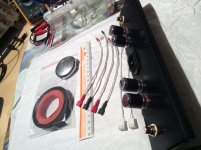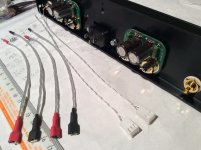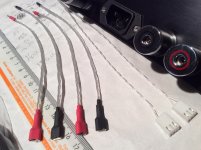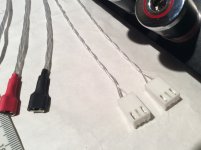"Truth will ultimately prevail where there is pains to bring it to light." George WashingtonDifferences between recording qualities are perceived as extreme.
The guys who have yet not heard the F.O. V1.4 can make jokes all day long...until they hear it. 😎
This amp is on the neutral side of neutrality and on the transparent side of transparency, hehe.
Cheers,
M.

Hi Andrej,
You should have called it First One 2.0 instead of 1.4 !
The difference in sound quality is much greater than the version numbering 🙂
With the FO 1.2 I was missing microdetails and soundstage, not so with the FO 1.4, compared to my F5 I can't hear which one is better in the mid/highs.
But in the bass and lowermids the FO 1.4 is better: bass is stronger and much more controlled, also more detailed bass.
The 1.4 also sounds more coherent throughout the whole frequency range, the same level of detail is heard in mid, highs and bass.
Time to update something else in my chain 🙂 the digital volume control will be replaced with an analog Tribute AVC (Shallco switches)
Regards,
Danny
You should have called it First One 2.0 instead of 1.4 !
The difference in sound quality is much greater than the version numbering 🙂
With the FO 1.2 I was missing microdetails and soundstage, not so with the FO 1.4, compared to my F5 I can't hear which one is better in the mid/highs.
But in the bass and lowermids the FO 1.4 is better: bass is stronger and much more controlled, also more detailed bass.
The 1.4 also sounds more coherent throughout the whole frequency range, the same level of detail is heard in mid, highs and bass.
Time to update something else in my chain 🙂 the digital volume control will be replaced with an analog Tribute AVC (Shallco switches)
Regards,
Danny
Great review.
If someone can compare the F.O. 1.4 versus the various NCore 400/500/1200 designs that would be appreciated. I know people compared the F.O. 1.2 to the NCore but I am specifically looking for the 1.4 vs. NCore comparisons. I know what LazyCat would say...however, I am interested in others doing the comparisons not LC ;-)
Thanks,
Anand.
If someone can compare the F.O. 1.4 versus the various NCore 400/500/1200 designs that would be appreciated. I know people compared the F.O. 1.2 to the NCore but I am specifically looking for the 1.4 vs. NCore comparisons. I know what LazyCat would say...however, I am interested in others doing the comparisons not LC ;-)
Thanks,
Anand.
P-CAD on the screen while writing this message. PCB has to be perfect so...Any news about the L boards, they arrive soon ?

There will be more to come from other builders, I know some of them have very good systems. Stay tuned. 😉Great review.
If someone can compare the F.O. 1.4 versus the various NCore 400/500/1200 designs that would be appreciated. I know people compared the F.O. 1.2 to the NCore but I am specifically looking for the 1.4 vs. NCore comparisons. I know what LazyCat would say...however, I am interested in others doing the comparisons not LC ;-)
Thanks,
Anand.
Some day it will be v2.0, now imagine that. 😉Hi Andrej,
You should have called it First One 2.0 instead of 1.4 !
The difference in sound quality is much greater than the version numbering 🙂
Try this on brand new (launching in 2-3 months) evaluation board and you'll hear how much FO is better in the mid/highs.With the FO 1.2 I was missing microdetails and soundstage, not so with the FO 1.4, compared to my F5 I can't hear which one is better in the mid/highs.
But in the bass and lowermids the FO 1.4 is better: bass is stronger and much more controlled, also more detailed bass.
The 1.4 also sounds more coherent throughout the whole frequency range, the same level of detail is heard in mid, highs and bass.

Wise thinking. 😎Time to update something else in my chain 🙂 the digital volume control will be replaced with an analog Tribute AVC (Shallco switches)
Regards,
Danny
Is this your first report on v1.4 ?
By "bad old" recordings I tend to think about digital from the eighties and nineties, or DG analog to digital...recordings from the 50's and 60's, with decent transfers to digital, sound very involving. The less filtering, the better...particularly, private transfers from vinyl to digital downloaded from the net are very OK.
The recording engineers are now (21th century) more aware, or have better instruments...or the producers let them do their job without interfering...I am talking here about classical music...
I discovered that some DDD CDs that sounded sterile before, have gained a lot of ampler soundstage, have more frequency extension, shows more "playing noises" (like plucking strings, moving chairs, falling objects...etc) which means lower noise floor and better detail retrieval. Strings attacks particularly are very convincing. As I said before, even with massive and complex orchestral passages, the amp maintain composure, while rendering a textured reproduction of the different sections' timbres.
Differences between recording qualities are perceived as extreme.
The guys who have yet not heard the F.O. V1.4 can make jokes all day long...until they hear it. 😎
This amp is on the neutral side of neutrality and on the transparent side of transparency, hehe.
Cheers,
M.
I have always found old DDD recordings very good but lifeless. With FO1.4 I can say that the engineers from the beginning of CD era knew what they were doing. There is actually a lot of life in those CDs.
Yes, I only listened some hours to it but the difference with 1.2 was heard immediately 🙂Is this your first report on v1.4 ?
It's in a preliminary case, but now that it has passed the first test 🙂 I will put it in a new 2U hifi2000 case with unregulated SMPS from Cresnet, those Cresnet SMPS have nice compact dimensions that makes an install easy.
On the way. Coming soon. 😉Cant wait to put my hands on the FO!
Agree in full. 😎I have always found old DDD recordings very good but lifeless. With FO1.4 I can say that the engineers from the beginning of CD era knew what they were doing. There is actually a lot of life in those CDs.
Make sure it will be dual mono exactly as per manual's sch (complete GND isolation). Expecting full report with pics (speakersYes, I only listened some hours to it but the difference with 1.2 was heard immediately 🙂
It's in a preliminary case, but now that it has passed the first test 🙂 I will put it in a new 2U hifi2000 case with unregulated SMPS from Cresnet, those Cresnet SMPS have nice compact dimensions that makes an install easy.
 ).
). 
Time to update something else in my chain the digital volume control will be replaced with an analog Tribute AVC (Shallco switches)
Wise move.
I use a TVC from Silk Audio in this, my second primary system. TVC allows for galvanic insulation. 😎
Cheers,
M.
Attachments
We love to watch porn
Thread is much more appealing if from time to time there are some pics. 😀
Thread is much more appealing if from time to time there are some pics. 😀
Attachments
Wise move.
I use a TVC from Silk Audio in this, my second primary system. TVC allows for galvanic insulation. 😎
Cheers,
M.
In the past I've already used a TVC from Sowter for some years, it was very good(better than most of the volume controls) but added too much of it's own sound signature (too smooth).
From what I've read an AVC seems to be more neutral than TVC, as an experiment it's possible to convert a TVC to an AVC, just connect the input to the secondaries instead of the primaries. I need to try that with the Sowter 🙂
Regards,
Danny
Last edited:
Thread is much more appealing if from time to time there are some pics. 😀
Is that silver cable?
Naimly silver, platinum, palladium and gold mixture in true teflon coating. Very smooth and nice to solder, 60 ultra thin filaments in one wire. As I've heard it will go to UV/VIS spectroscopy analysis to see what's inside for real, but so far speaker and interconnect cables show very promising results.
In the past I've already used a TVC from Sowter for some years, it was very good(better than most of the volume controls) but added too much of it's own sound signature (too smooth).
From what I've read an AVC seems to be more neutral than TVC, as an experiment it's possible to convert a TVC to an AVC, just connect the input to the secondaries instead of the primaries. I need to try that with the Sowter 🙂
Regards,
Danny
This is no O.T. since we want the most transparent signal to feed our F.O. 🙂
I am aware of the potential increase in linearity with AVC configuration and how to do it. This is another good point about TVC: it can be either an AVC or a TVC...not to mention balanced to single ended conversion.
I also own a S&B with OCC copper 😎 which does the job in the other primary system.
Another strong point of inductive attenuation is the subjective increase in dynamics (or absence of decay) when feeding with "high Vout" sources and lower chosen secondaries (counter clock-wise turn of volume pot), or "low level" listening, in opposition to what happens with pure resistive attenuation. 😉
Cheers,
M.
OK, you know the AVC-TVC stuff 🙂
Time for me to assemble the Tribute AVC so I can feed the FO even better 🙂
I bought the Tribute AVC without the standard Elma switch so I could use my own switches.
Time for me to assemble the Tribute AVC so I can feed the FO even better 🙂
I bought the Tribute AVC without the standard Elma switch so I could use my own switches.
Naimly silver, platinum, palladium and gold mixture i....
A galvanic noise "battery"?
//
- Home
- Vendor's Bazaar
- First One - mosFET amplifier module






